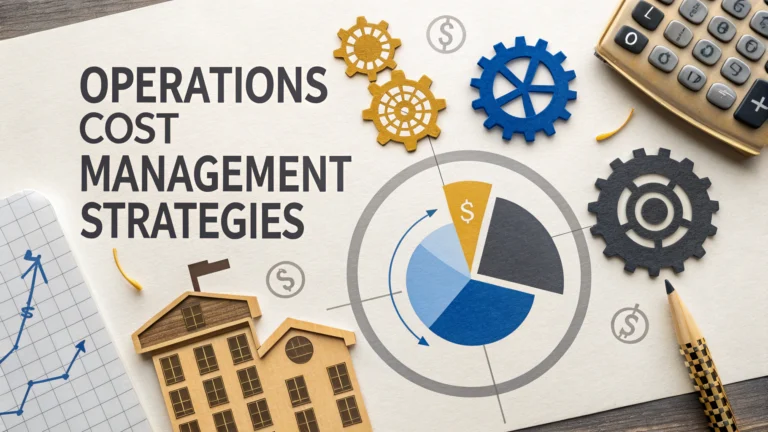Operations cost management directly impacts a company’s bottom line by optimizing expenses while maintaining quality and efficiency.
The role of a Chief Operating Officer (COO) includes developing and implementing strategies that reduce operational costs without compromising business performance.
This guide explores practical approaches to operations cost management, with actionable steps for COOs and operations leaders.
Key Areas of Operations Cost Management
- Labor and workforce optimization
- Supply chain efficiency
- Process automation
- Resource allocation
- Vendor management
- Technology infrastructure
Workforce Optimization Strategies
Implement cross-training programs to increase workforce flexibility and reduce dependency on specialized staff.
Use workforce management software to optimize scheduling and reduce overtime costs.
- Review staffing levels against productivity metrics
- Analyze peak operation times
- Consider flexible working arrangements
- Invest in employee development
Supply Chain Cost Reduction
Establish strong supplier relationships and negotiate volume-based discounts.
| Strategy | Potential Savings |
|---|---|
| Bulk purchasing | 10-15% |
| Supplier consolidation | 5-20% |
| Just-in-time inventory | 20-30% |
Process Automation Benefits
Identify repetitive tasks suitable for automation to reduce labor costs and improve accuracy.
- Document management systems
- Automated billing and invoicing
- Inventory management software
- Quality control automation
Resource Allocation Optimization
Use data analytics to make informed decisions about resource distribution.
- Equipment utilization tracking
- Energy consumption monitoring
- Space optimization
- Material usage analysis
Vendor Management Best Practices
Regular vendor performance reviews help identify opportunities for cost savings.
- Competitive bidding processes
- Service level agreements
- Payment terms optimization
- Regular market analysis
Technology Infrastructure Management
Evaluate and optimize technology spending through regular audits and updates.
- Cloud vs. on-premise solutions
- Software license management
- Hardware lifecycle planning
- IT support optimization
Measuring Cost Management Success
Track key performance indicators (KPIs) to measure the effectiveness of cost management initiatives.
- Cost per unit produced
- Operating expense ratio
- Labor cost percentage
- Return on investment (ROI)
Next Steps for Implementation
Begin with a thorough cost analysis of current operations to identify areas with the highest potential for savings.
Create a phased implementation plan with clear milestones and accountability measures.
Contact professional operations consulting firms like Boston Consulting Group or McKinsey & Company for specialized guidance in operations cost management.
Implementation Timeline and Phases
Develop a structured timeline for implementing cost management initiatives across different operational areas.
- Phase 1: Analysis and Assessment (1-2 months)
- Phase 2: Strategy Development (2-3 months)
- Phase 3: Pilot Implementation (3-4 months)
- Phase 4: Full-Scale Rollout (6-12 months)
Risk Management Considerations
Address potential risks associated with cost reduction initiatives to ensure sustainable implementation.
- Quality control measures
- Employee morale monitoring
- Customer satisfaction tracking
- Operational continuity planning
Change Management Strategies
Employee Communication
Maintain transparent communication about cost management initiatives with all stakeholders.
- Regular update meetings
- Progress reports
- Feedback channels
- Training sessions
Stakeholder Engagement
Engage key stakeholders throughout the cost management process to ensure buy-in and support.
Sustaining Long-Term Cost Efficiency
Establish systems and processes to maintain cost efficiency beyond initial implementation.
- Regular performance reviews
- Continuous improvement programs
- Benchmark analysis
- Technology updates
Driving Operational Excellence Through Strategic Cost Management
Successful operations cost management requires a balanced approach between cost reduction and maintaining operational excellence.
Focus on creating sustainable cost management practices that align with long-term business objectives and growth strategies.
Regularly review and adjust strategies based on market conditions, technological advancements, and organizational needs to ensure continued effectiveness and competitiveness.
FAQs
- What are the key components of operations cost management?
Operations cost management involves direct labor costs, materials and inventory, overhead expenses, technology infrastructure, facility costs, supply chain optimization, and quality control measures. - How can businesses effectively reduce operational costs without compromising quality?
Businesses can reduce costs by implementing lean management principles, automating repetitive tasks, optimizing resource allocation, negotiating with suppliers, improving energy efficiency, and streamlining processes while maintaining quality standards. - What role does technology play in operations cost management?
Technology enables cost reduction through automation, data analytics for decision-making, inventory management systems, predictive maintenance, digital workflow solutions, and real-time monitoring of operational expenses. - How do you measure the success of cost management initiatives?
Success is measured through key performance indicators (KPIs) such as cost per unit, operating margin, inventory turnover ratio, labor productivity metrics, return on investment (ROI), and overall operational efficiency improvements. - What are common challenges in implementing cost management strategies?
Common challenges include employee resistance to change, initial investment requirements, maintaining service quality, accurate cost allocation, supply chain disruptions, and balancing short-term savings with long-term sustainability. - How does outsourcing impact operations cost management?
Outsourcing can reduce operational costs through labor arbitrage, access to specialized expertise, reduced overhead expenses, and improved scalability, but requires careful vendor management and quality control. - What is the importance of cost allocation in operations management?
Cost allocation helps identify true costs of products or services, enables accurate pricing decisions, highlights inefficiencies, supports budgeting processes, and facilitates departmental accountability. - How can sustainable practices contribute to cost management?
Sustainable practices reduce costs through energy efficiency, waste reduction, resource optimization, improved brand reputation, regulatory compliance, and reduced environmental impact fees. - What are effective inventory management strategies for cost reduction?
Effective strategies include just-in-time inventory, ABC analysis, optimal reorder points, demand forecasting, vendor-managed inventory, and automated inventory tracking systems. - How do labor costs impact overall operations management?
Labor costs typically represent a significant portion of operational expenses and are influenced by workforce planning, scheduling efficiency, training programs, productivity measures, and compensation structures.
